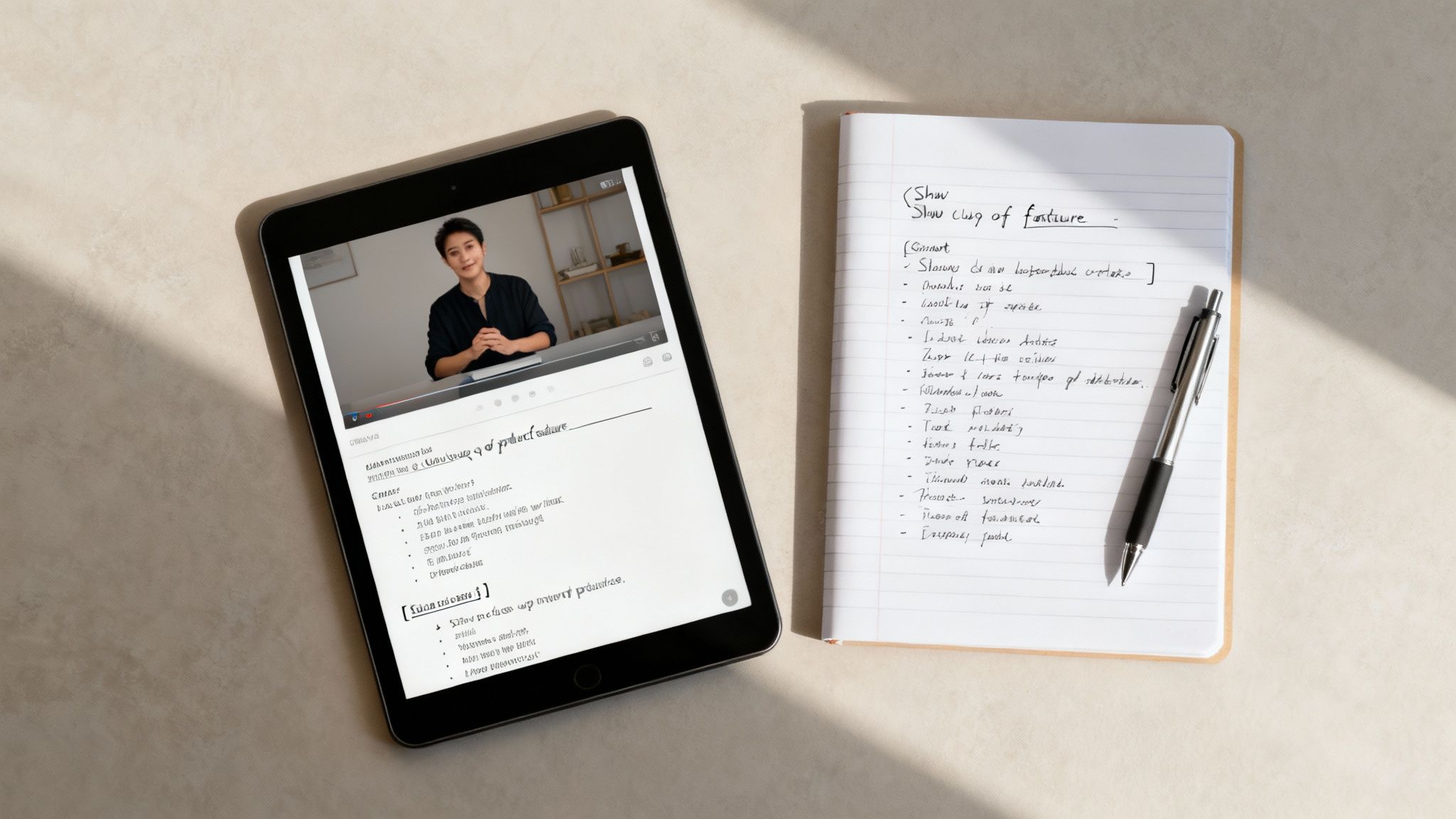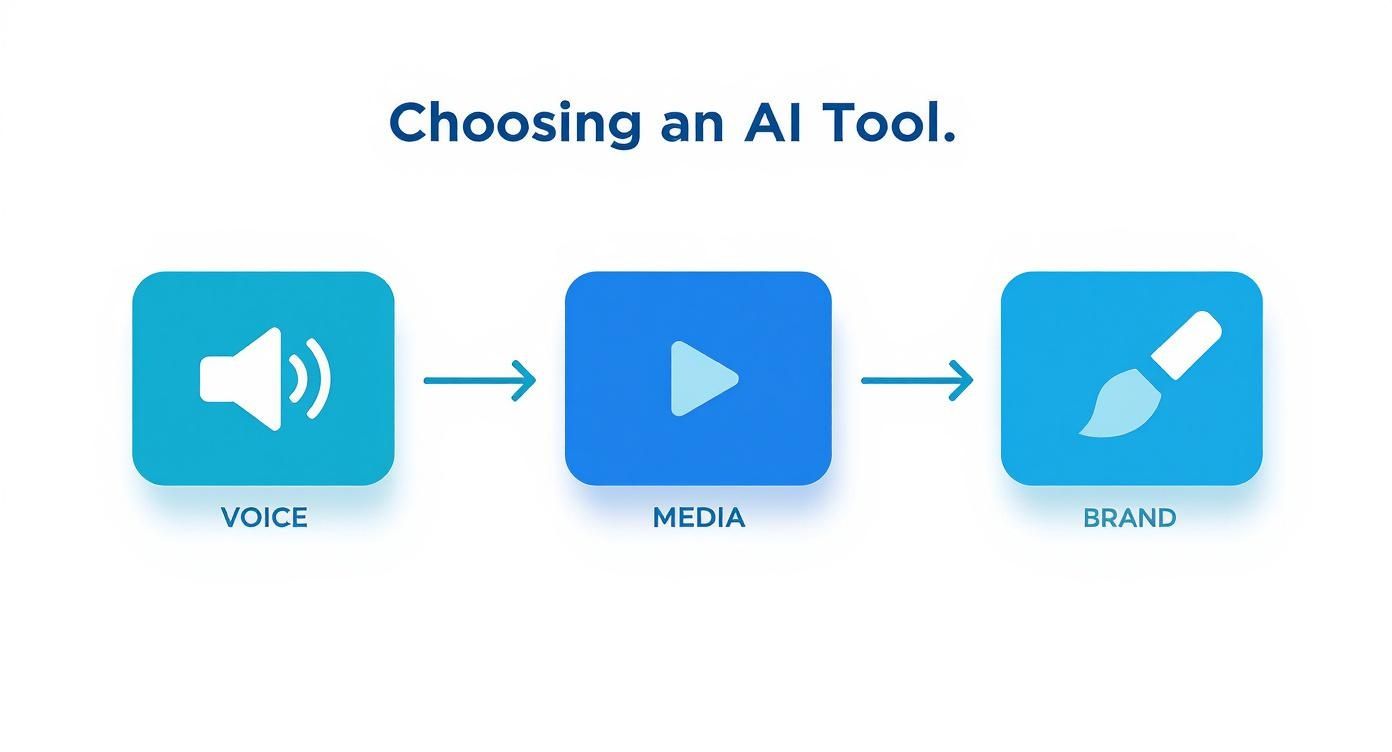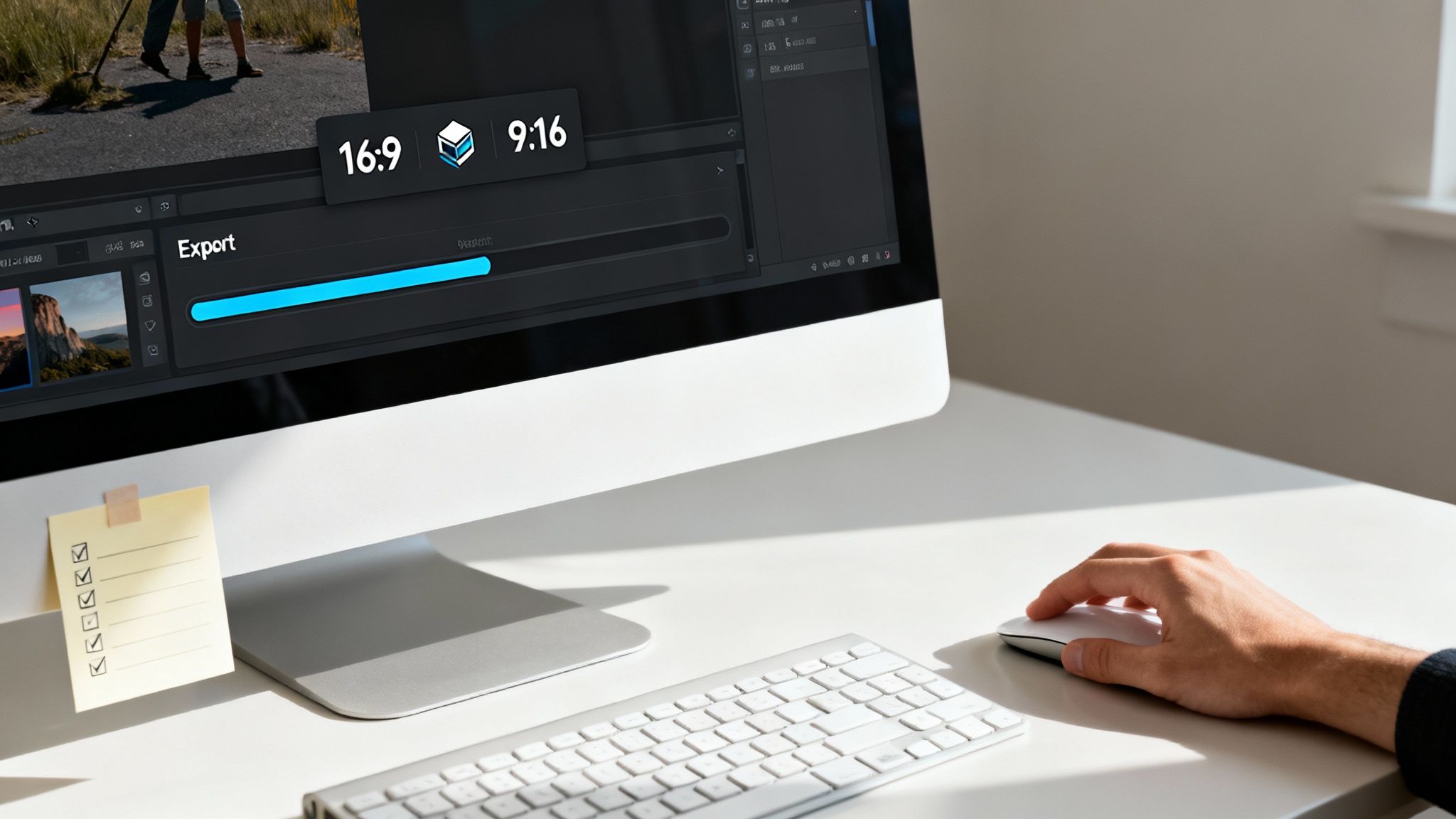A Practical Guide to Turning Your Script to Video
Turning your script into a finished video sounds complicated, but with the right AI tools, it's actually become surprisingly straightforward. The whole idea is to feed your written text into a smart platform that then automates the heavy lifting—generating visuals, creating a voiceover, and even adding animated captions.
What you're left with is a shareable, engaging video, created in a fraction of the time it would normally take.
Why Bother Turning a Script into a Video?

Let's be real: moving beyond blog posts isn't just a "nice to have" anymore. It's a core part of any serious content strategy. Why? Because video taps into how our brains are wired. Combining what we see with what we hear makes a message stick in a way text just can't compete with.
This isn't just a fleeting trend. It reflects a deep shift in how we all consume content. Platforms like TikTok, Instagram, and YouTube have trained us to expect information that's dynamic and easy to digest. Turning your script into a video is simply meeting your audience where they already are.
The Massive Demand for Video Content
This hunger for video has created a huge market for tools that make production easier. The text-to-video AI market is on track to explode, growing from USD 0.4 billion in 2025 to USD 1.18 billion by 2029.
This growth is being driven by everyone from social media managers to educators and marketers who need a steady stream of visual content. In fact, a recent survey found that a whopping 91% of businesses are now using video in their marketing. If you want to dig deeper, you can explore the data on the AI video market's growth and see just how central it's becoming to content creation.
The Bottom Line: The explosion in video demand means creators and businesses who don't adapt are going to get left behind. AI script-to-video tools are the bridge, making high-quality production accessible to everyone, not just those with a film crew and a massive budget.
This new accessibility has leveled the playing field. Individual creators and small businesses can now produce professional-looking videos that genuinely connect with people. The workflow is pretty simple:
- Drop in your script to get a first draft of the video.
- Pick a voiceover that fits your brand's personality.
- Tweak the visuals and pop in your own branding.
- Add animated captions to keep people hooked, even with the sound off.
By adopting this script-to-video process, you can get your message out there more effectively, build a stronger community, and grow your online presence much faster than you ever could with text alone.
How to Write a Script That’s Ready for Video

Here's the first thing you need to understand: writing for video is a totally different ballgame than writing a blog post. When you're creating a script to video, those words are meant to be spoken and heard, not just scanned on a page. This means you need to adopt a much more direct, conversational tone.
Think about how you talk in real life. You probably use shorter sentences, maybe some contractions, and you get straight to the point. Your script should feel the same way. Ditch the complex sentences and industry jargon. Your goal is to be so clear and simple that your message lands perfectly on the first listen.
Crafting a Strong Narrative Structure
Every great video, no matter how short, has a solid structure. It’s a simple framework that grabs your audience and doesn't let go until the very end. Without it, you risk losing viewers before you even get to the good stuff.
A winning script almost always breaks down into three parts:
- The Hook: You have 3-5 seconds—that's it. You need to start with a bang. Ask a provocative question, state a surprising fact, or introduce a problem your audience immediately understands.
- The Value: This is the meat of your video. Here's where you deliver on the promise you made in the hook. Break down your main points into easy-to-digest pieces of information.
- The Conclusion: Don't just fade out. End with a clear Call to Action (CTA). Tell your viewers exactly what to do next. Should they follow you? Leave a comment? Visit your website? Be specific.
This structure turns a collection of facts into a compelling narrative that keeps people engaged.
Pro Tip: I can't stress this enough: read your script out loud. It’s the single best way to catch clunky phrasing and sentences that ramble on. If it sounds awkward when you say it, you can bet the AI voice will struggle with it, too.
Embedding Visual Cues for the AI
Want to make the script to video process incredibly smooth? Start adding visual instructions right into your text. Think of them as director's notes for the AI. This little trick ensures the visuals match your narration perfectly and will save you a ton of editing time later on.
You don't need anything fancy. Just use simple, clear language inside brackets to guide the AI on what to show on screen.
For instance, you might write:
The results were staggering. [Show a graph with an upward trend]Our customers absolutely love this feature. [Transition to customer testimonial footage]Let's take a closer look. [Show close-up of product feature]
By embedding these cues, you’re taking control of the visual story. You're not just hoping the AI gets it right; you're telling it exactly what you need to create a polished, professional video from the very first draft.
Choosing the Right AI Script to Video Tool
The number of AI video tools out there has absolutely exploded. It can feel overwhelming trying to pick the right one for your script to video projects when a new option seems to pop up every week. To give you some perspective, the AI video market was valued at USD 7.6 billion in 2024 and is expected to rocket to USD 156.57 billion by 2034. That's a ton of growth and a lot of new tools vying for your attention. You can discover more insights about the AI video market's future if you're curious about the numbers.
With so many choices, you've got to cut through the noise. The real difference between a decent tool and a fantastic one isn't about flashy landing pages; it's about the core features that actually affect your workflow and the quality of your finished video.
What Truly Matters in an AI Video Tool
When you start comparing platforms, don't get distracted by a long list of minor features. From my experience, it really boils down to three make-or-break components that separate a polished, professional video from one that just screams "AI-generated."
-
Voice Quality and Variety: This is a big one. Does the AI voice sound like a real person, or does it have that flat, robotic tone? A top-tier tool will give you a library of voices with different accents, genders, and even emotional tones (like confident, calm, or energetic). You need that flexibility to find a voice that truly represents your brand.
-
Media Library Depth: A weak stock media library is a dealbreaker. If the footage and images are generic or low-quality, you'll end up spending hours (and money) finding better visuals elsewhere. Look for a platform with a deep, diverse library of high-resolution clips that actually fit various industries and topics.
-
Customization and Branding: Your videos need to look like your videos, not like a template. How easily can you add your logo, apply your brand's color palette, and use your specific fonts? The ability to tweak things like caption animations and transition styles is what will make your content stand out and feel unique.
Key Takeaway: The best tool isn't always the one with the most bells and whistles. It's the one that gets the fundamentals right. A natural-sounding voiceover and high-quality, relevant visuals are far more valuable than a dozen clunky, rarely-used features.
Before you commit to a tool, it’s worth taking a look at a few key features that can make or break your video creation process.
Key Features in Script to Video AI Tools
| Feature | What to Look For | Why It Matters |
|---|---|---|
| Voice Cloning | The ability to upload samples of your own voice to create a custom AI clone. | Creates a consistent, authentic brand voice across all your video content. |
| Asset Library Quality | High-resolution, diverse stock footage, images, and music tracks. Avoid generic or dated content. | A strong library saves you time and money, preventing the need to source visuals externally. |
| Dynamic Captions | Variety in animation styles (e.g., pop-up, karaoke-style) and full control over fonts, colors, and placement. | Engaging captions are crucial for viewer retention, especially on mobile where many watch with sound off. |
| Branding Kits | The option to save your brand's logos, color palettes, and fonts for easy application across all projects. | Ensures brand consistency and dramatically speeds up your editing workflow. |
| Export Options | Support for various aspect ratios (16:9, 9:16, 1:1) and high-quality export resolutions (e.g., 1080p, 4K). | Your video needs to look great on every platform, from YouTube to TikTok to Instagram. |
| Ease of Use | An intuitive, user-friendly interface that doesn't require a steep learning curve. | You want to spend your time creating, not fighting with a complicated tool. |
Ultimately, the best tool is the one that aligns with your specific goals, whether you're making quick daily social media clips or more detailed instructional videos. For a great comparison of what different platforms bring to the table, check out this AI Video Generator From Text: The Ultimate Guide.
Finally, don't forget to look at the pricing. Most tools have different tiers, so figure out which features are non-negotiable for you and find a plan that fits. For a straightforward look at how this works, you can explore our clear breakdown of ClipShort pricing plans.
A Walkthrough of the Video Creation Workflow
https://www.youtube.com/embed/U5HyW5tDXYM
Alright, this is where the fun really starts. Taking a script you've painstakingly perfected and turning it into a finished video is all about refinement. You're essentially the director, guiding the AI to nail your creative vision. The first part is dead simple: you feed your script into the tool, and it spits back a first draft complete with narration and a solid sequence of visuals.
But don't stop there. The real craft comes in the editing. This is your chance to take that initial AI output and polish it into something that genuinely feels like your brand. Think of the first draft as a starting point, a canvas waiting for your expertise.
Refining Your AI-Generated Video
The AI does a surprisingly good job of picking visuals based on keywords in your script, but you'll always want to do a manual review. Your human touch is what adds context and nuance.
For instance, if your script mentions “customer success,” the AI might pull a generic stock clip of a handshake. That's okay, but you can do better. A quick swap for a clip showing a real customer smiling while using your product? That's far more powerful.
Pacing is another area where your input is crucial. You need to fine-tune the duration of each scene, making sure the visuals hit their mark right as the voiceover mentions them. Getting that timing just right is what makes a video feel professional and synchronized. For a deeper dive into this, we have a whole guide on how to create a short video that covers pacing in more detail.
This whole refinement process—from voice to media to branding—is laid out in the infographic below.

You can see how each step builds on the last, turning that basic script into a branded, engaging piece of content.
Adding Your Brand and Final Touches
Consistency is everything when it comes to brand recognition. A good script-to-video tool should make it easy to weave your brand's identity throughout the video, and I'm not just talking about sticking a logo in the corner.
- Incorporate Your Colors: Use your specific brand palette for text, backgrounds, and especially for highlighting animated captions.
- Add Your Logo: Place your logo as a subtle watermark. It should reinforce your brand, not shout over your content.
- Animate Your Captions: Dynamic captions are a must. They keep viewers hooked, especially the huge chunk of your audience watching with the sound off.
- Select Background Music: The right music track sets the entire mood. Are you going for upbeat and energetic, or something more calm and corporate? Choose wisely.
This kind of workflow is quickly becoming a non-negotiable for content teams. The market data backs this up, too. The global AI video generator market was valued at USD 534.4 million in 2024 and is expected to balloon to USD 2.56 billion by 2032. With AI-powered solutions already making up over 63% of the revenue, it's clear that businesses are all-in on this technology. You can learn more about AI video generator statistics to get the full picture.
Key Insight: The difference between a good AI-generated video and a great one comes down to the details. Spend that extra time refining the visuals, applying your unique brand identity, and getting the audio mix just right. That's how you create content that truly stands out and connects.
How to Finalize and Export Your Video

Alright, your script is now a living, breathing video. But don't just smash that export button and call it a day. The final settings you choose are what truly separate a polished piece of content from something that just looks… off. This last part is crucial for making sure your video actually performs well out in the wild.
First up, you need to lock in the aspect ratio. Think of this as the shape of your video's canvas, and it’s entirely dependent on where your audience will be watching. A horizontal 16:9 ratio is the classic YouTube look, perfect for desktops and TVs. For anything that lives on a phone screen—like TikTok, Instagram Reels, or YouTube Shorts—you absolutely need a vertical 9:16 ratio. Get this wrong, and you'll end up with those ugly black bars that scream "amateur."
Then comes resolution. It’s tempting to crank everything up to 4K, but for most social media, 1080p (1920x1080 pixels) is the gold standard. It gives you that sharp, professional quality without creating a monster file that takes forever to upload or buffers endlessly for your viewers.
Your Pre-Publishing Checklist
I can’t tell you how many times I've seen great videos undermined by a simple, avoidable mistake. That's why I always run through a quick pre-flight check before exporting. It’s a simple habit that saves a lot of headaches later.
Here’s my personal checklist:
- Caption Check: Read every single caption one last time. A silly typo can tank your credibility in a second.
- Audio Balance: Throw on some headphones for this. Can you clearly hear the voiceover above the music? If the audio mix is off, people will just swipe away.
- Branding Consistency: Are your logo and brand colors correct? Little details like this build brand recognition over time.
- Final Play-Through: Watch the video from beginning to end, as if you were a viewer. You'll be surprised what you catch—an awkward cut, a visual that doesn’t quite land, or a pacing issue you missed while you were deep in the weeds of editing.
A quick final check ensures your video lands perfectly every time. It’s the last line of defense for your brand's professionalism and confirms your content is truly ready for an audience.
For those looking to maximize accessibility, learning about an SRT export guide can be a game-changer for adding captions to other platforms.
Once you’re confident everything is perfect, it’s time to share your work. If you’re publishing to Shorts, we have a complete walkthrough right here: https://www.clipshort.co/en/blog/how-to-upload-youtube-shorts.
Common Questions About Script to Video Tools
Diving into the world of AI video creation for the first time? It's natural to have a few questions before you upend your entire workflow. Let's walk through some of the things that come up most often when creators start exploring the script to video process.
Can an AI Voice Really Capture the Right Emotion?
This is a big one. Can a machine truly sound... human? You'd be surprised. Modern AI voice generators have gotten incredibly sophisticated, letting you pick from a whole menu of tones like ‘professional,’ ‘enthusiastic,’ or ‘calm.’ The real trick is in how you write. By sprinkling descriptive words and using specific punctuation in your script, you can guide the AI's delivery with a lot of precision.
A professional human voiceover might still have the edge for a deeply emotional or character-driven piece. But for most marketing and educational videos, today's AI voices are more than capable—and way faster.
How Long Should My Script Be?
The honest answer? It depends entirely on where you plan to post your video. A script for a quick TikTok is going to look very different from one for a detailed YouTube explainer.
- TikTok & Instagram Reels: You’ve got to be fast. Think 30-60 seconds, which means your script should be around 75-150 words. Get to the point and deliver value immediately.
- YouTube & Website Explainers: Here you have more room to breathe. A 2-3 minute video, which is often the sweet spot for engagement, needs a script of about 300-450 words.
What's the Biggest Mistake People Make?
The most common pitfall is treating the AI's first output as the final product. Always, always review and tweak the visuals the AI selects. You need to make sure they actually match the context and message of your script. A close second is starting with a weak script in the first place—remember, the AI is a tool, not a storyteller. It can't salvage a confusing or poorly written narrative.
Is the Video Content Safe to Use?
This is a crucial question. Are the videos you create with these tools copyright-free? For the most part, yes. Reputable platforms like ClipShort build their tools on top of licensed stock media libraries.
When you generate a video, you're granted a license to use that final creation for its intended purpose, whether that's for social media marketing or a company presentation. Still, it's always a good idea to quickly scan the terms of service for whatever tool you're using. It’s better to be safe and understand the exact usage rights you have.
Ready to turn your ideas into engaging videos without the headache? ClipShort gives you the power to create professional, scroll-stopping content in minutes. Start creating for free today.